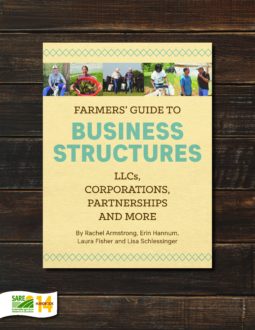The objective of this Guide is to help farmers decide which entity is best for their farm operation and to then take steps to actually form and uphold that entity. Ultimately, this Guide encourages farmers to be resourceful and do some of the legwork themselves. Not only will this save money in professional fees for attorneys and accountants, it will also equip the farmer with key knowledge on how to run a successful business. This Guide is organized to help you along the four-step path: Decide, Form, Organize and Implement.
Decide
The next chapter provides two tools to help farmers actually decide which business entity is best for their farm operation: Entity Comparison Chart and Choose Your Entity Flowchart. These charts will help farmers narrow down the options based on certain factors or characteristics of the business entity.
Part 2 of this Guide includes chapters on each of the main entities: sole proprietorship and general partnership, LLC, C corporation, S corporation, B corporation, cooperative and nonprofit (incorporated and unincorporated). Once you have narrowed down your choices by using these charts, the next step is to review the entity-specific chapter or chapters (if you’re still narrowing it down from two or three options). These chapters can help you affirm your decision by giving you a more thorough understanding of the characteristics, benefits and drawbacks, and requirements for that particular entity.
Before finalizing a decision, farmers should consult the Special Issues section. Farmers in certain states, farmers with diversified operations and farmers forming a multi-farm venture should review these chapters for additional decision-making considerations.
Form
With an initial decision in hand, farmers need to know what it takes to form their chosen entity. How does a person set up the entity? What documents need to be filed and with whom? Many farmers choose the LLC or the corporation (generally taxed as an S corporation with the IRS). The Going Deeper sections in the LLC and C corporation chapters include even more materials, such as a checklist on creating an LLC and a checklist for creating a C corporation. These checklists walk through a step-by-step process to help farmers form these particular business entities.
Organize
The entity-specific chapters also outline the steps required to organize the entity. Primarily, this includes creating the organizing document–or the bylaws, partnership agreement or operating agreement. Again, the Going Deeper sections of the LLC chapter and the C corporation chapters include more extensive tools, including sample organizing documents and checklists for creating an organizing document. The organizing step also includes setting up the management structure, such as appointing a board of directors or managers, depending upon the entity. This step is discussed in the entity-specific chapters. For the LLC and the C corporation, these steps are further detailed in the Creating an LLC Checklist and the Creating a C Corporation Checklist.
Implement
Finally, each of the entity-specific chapters includes an Implementing Best Business Practices section, which highlights the requirements and best practices that are specific to that entity.
